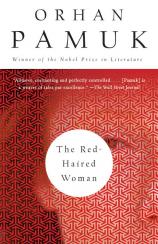The Red-Haired Woman
Review
The Red-Haired Woman
Turkish novelist Orhan Pamuk is best known for his novel SNOW, which was awarded the first Nobel Prize for Literature for Turkey in 2006. He has since earned several other literary awards.
Pamuk is a born storyteller who writes in a Middle Eastern tradition based on fables, ancient Greek literature, myth, metaphor and morality plays. If you have ever watched Turkish or Iranian films, you will recognize the slow-paced interwoven pattern of the village mentality, mysticism, and the extraordinary visual and atmospheric effects of the Middle East that so define these ancient lands.
This modern-day fable begins in the 1980s and introduces readers to Cem, whose father, a local village pharmacist, is imprisoned for subversive activities and tortured. Turkey is under martial law, and Cem’s father subsequently vanishes from his family’s life, leaving Cem and his mother nearly destitute. At age 15, he dreams only of becoming a writer and is studying for the crucial final exam that will allow him admittance to college. He is torn between helping his mother and furthering his education, so he accepts a job as a well-digger’s assistant to earn extra money for her on which to live.
"The allure that Pamuk evokes in this haunting tale of hardship, unrequited love, guilt, danger, dreams fulfilled and dreams destroyed is the stuff that Eastern literature tragedies are made of."
Written in first-person present tense, the first part of the novel introduces us to the drudgery of this ancient craft of the hand-dug well in the bleak countryside outside of Istanbul. A bond develops between the fatherless boy and Master Mahmut, the well-known well digger who takes him under his wing. During this brief and grueling summer, Cem spies a beautiful red-haired woman in the town near the well-digging project. Obsessed with her beauty to the point of distraction, he spends what little free time he has staring at the windows of her apartment and following her from the shadows. One night, his adolescent dream is realized when the Red-Haired Woman invites him to her apartment. The next morning, the traveling theatrical troupe leaves the village. A catastrophic event follows that will haunt him throughout his life.
The story then progresses to a later time. Cem has gone on to receive his degree as a geological engineer, and meets and marries a suitable woman. He and his new wife share an interest in the arts and literature. Childless, they travel to the Middle East, studying Greek and Iranian tragedies and visiting museums. They are especially drawn to “Oedipus the King” and a similar Iranian fable about Rostam and Sohrab, tales of fratricide and patricide. Together, they create a successful corporation, enjoying riches far beyond what they could have dreamed.
Cem’s company receives an opportunity to develop a lucrative project near the site where he once worked with Master Mahmut. He takes on the project with some trepidation, yet is curious to find out what happened after the accident.
The allure that Pamuk evokes in this haunting tale of hardship, unrequited love, guilt, danger, dreams fulfilled and dreams destroyed is the stuff that Eastern literature tragedies are made of. They are not unlike Shakespearean melodramas with their intense, dramatic morality themes of murder, regret, love and deceit.
Reviewed by Roz Shea on August 25, 2017
The Red-Haired Woman
- Publication Date: July 10, 2018
- Genres: Fiction
- Paperback: 272 pages
- Publisher: Vintage
- ISBN-10: 1101974230
- ISBN-13: 9781101974230





